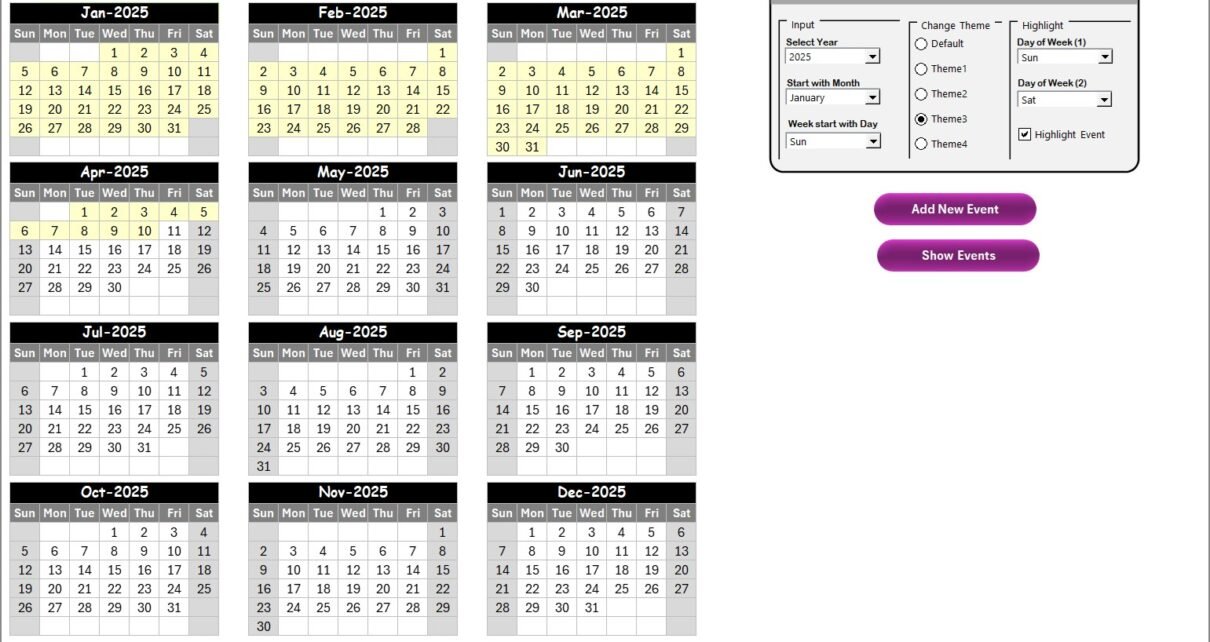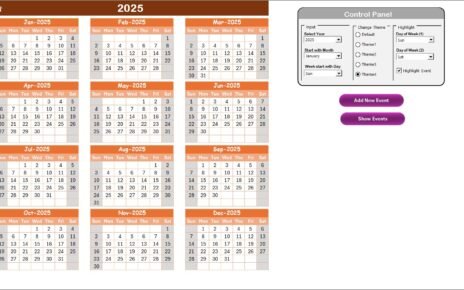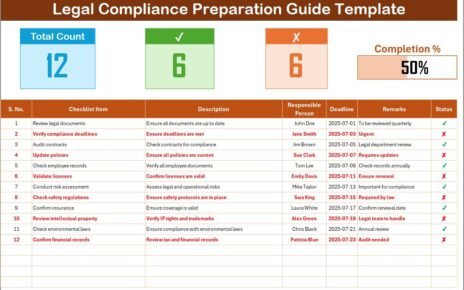Finance compliance and customer experience are two sides of the same coin in today’s business world. While financial compliance ensures that organizations follow strict rules and regulations, customer experience guarantees that clients feel valued, safe, and well-served. Balancing these two priorities often becomes complex, especially when multiple departments, deadlines, and tasks overlap.
This is where the Finance Compliance Customer Experience Calendar in Excel becomes an essential tool. With this ready-to-use calendar, companies can align compliance tasks with customer experience initiatives, ensuring accountability, transparency, and efficiency. The Excel format makes it user-friendly, customizable, and scalable for businesses of all sizes.
In this article, we will explore everything you need to know about the Finance Compliance Customer Experience Calendar in Excel — from its features and benefits to best practices and real-world use cases.
Click to Purchases Finance Compliance Customer Experience Calendar in Excel
What is a Finance Compliance Customer Experience Calendar in Excel?

A Finance Compliance Customer Experience Calendar is a structured Excel template designed to help businesses plan, monitor, and execute compliance tasks while also tracking activities that impact customer experience.
Instead of scattered notes or fragmented tools, this calendar consolidates tasks, deadlines, responsible persons, and progress into one centralized sheet. It helps compliance officers, finance teams, and customer service managers work together seamlessly.
The calendar typically includes:
-
S.No. – Serial numbering for easy tracking.
-
Date – Scheduled date for compliance or customer task.
-
Day – Automatic day assignment for better scheduling.
-
Event Name – Task or initiative title (e.g., “Quarterly Audit Review” or “Customer Feedback Workshop”).
-
Time – Meeting or task execution time.
-
Location – Physical or virtual location for the task.
-
Description – Short notes about the event or compliance activity.
This structure ensures that both compliance requirements and customer experience tasks stay visible, actionable, and measurable.
Key Features of the Finance Compliance Customer Experience Calendar
Using Excel for compliance and customer experience management provides multiple built-in benefits. Let’s look at the key features:
1. User-Friendly Design
The template requires no advanced technical knowledge. Anyone familiar with Excel can use it.
2. Centralized Task Management
All finance and compliance tasks, along with customer-focused initiatives, stay in one sheet. This eliminates confusion.
3. Automatic Day Assignment
Dates automatically populate their corresponding weekdays, ensuring no tasks fall on non-working days unnoticed.
4. Deadline Tracking
Deadlines help teams meet regulatory requirements and customer expectations on time.
5. Customizable Fields
Businesses can edit event names, time slots, or descriptions as per their unique needs.
6. Reusable Format
The calendar works year after year by simply updating dates.
7. Scalable Use
From small businesses to multinational corporations, the template adapts to different levels of complexity.
Why Do Businesses Need a Finance Compliance Customer Experience Calendar?
Many organizations struggle to balance compliance obligations with customer satisfaction. Without a structured system, tasks may be delayed or forgotten. Here’s why this Excel calendar matters:
-
Regulatory Compliance: Stay on top of mandatory audits, reporting, and financial reviews.
-
Customer Trust: Align financial integrity with customer experience initiatives to build long-term relationships.
-
Efficiency: Centralize compliance and customer tasks in one place, reducing wasted time.
-
Transparency: Assign clear accountability for each task.
-
Consistency: Standardize operations across multiple departments.
-
Audit Readiness: Generate quick records during inspections or audits.
Click to Purchases Finance Compliance Customer Experience Calendar in Excel
Advantages of Using the Finance Compliance Customer Experience Calendar in Excel
Adopting this calendar offers several business advantages:
✅ Centralized Tracking: Manage compliance and customer experience tasks in one document.
✅ Flexibility: Customize fields and adapt to different industries.
✅ Compatibility: Works with any version of Excel across devices.
✅ Cost-Effective: Avoid expensive compliance management software.
✅ Time-Saving: Automates dates, days, and tracking, reducing manual errors.
✅ Clarity: Each team member knows their responsibility and deadlines.
✅ Scalability: Suitable for small teams and enterprise-level organizations.
How to Use the Finance Compliance Customer Experience Calendar in Excel
Here’s a simple step-by-step guide:
Step 1: Download and Open the Template
Open the Excel file. You’ll see a calendar format with task columns.
Step 2: Add Responsible Persons
Fill in team members’ names against each compliance or customer activity.
Step 3: Enter Event Names
Examples include:
-
“Quarterly Compliance Audit”
-
“Customer Feedback Survey Launch”
-
“Data Security Training Session”
Step 4: Set Deadlines and Time Slots
Enter specific dates and times for tasks to avoid clashes.
Step 5: Add Locations and Notes
Mention where the event will occur or provide links for virtual meetings.
Step 6: Track Progress
Review the calendar weekly or monthly to ensure timely execution.
Real-World Applications of the Calendar
Different industries can adapt this tool to their compliance and customer needs:
-
Banking & Finance: Schedule audits, compliance filings, and customer engagement drives.
-
Healthcare: Track HIPAA compliance training and patient experience programs.
-
Retail & E-Commerce: Align financial reporting with customer loyalty initiatives.
-
Education: Plan regulatory reporting alongside student experience surveys.
-
IT & Consulting: Monitor data security compliance while improving client feedback loops.
Best Practices for Using the Finance Compliance Customer Experience Calendar
To maximize value, follow these best practices:
📌 Update Regularly: Keep the calendar current to reflect ongoing changes.
📌 Assign Clear Roles: Ensure each task has a dedicated owner.
📌 Use Deadlines Wisely: Set realistic but firm deadlines.
📌 Review Progress Frequently: Weekly or monthly reviews prevent bottlenecks.
📌 Train Your Team: Educate staff about compliance and customer responsibility.
📌 Secure the File: Store the calendar safely in cloud storage or encrypted drives.
Opportunities for Improvement in the Calendar
Although powerful, this Excel calendar can be enhanced with a few upgrades:
🔹 Integration with Power BI: Create dashboards for advanced visualizations.
🔹 Conditional Formatting: Highlight overdue tasks automatically.
🔹 Macros for Reminders: Trigger email or pop-up alerts for deadlines.
🔹 Collaboration Links: Share on SharePoint or Google Drive for team access.
🔹 Risk Categories: Add a risk impact column for compliance prioritization.
Conclusion
Finance compliance and customer experience are critical for long-term business success. With a Finance Compliance Customer Experience Calendar in Excel, organizations gain a simple yet effective way to manage compliance obligations while ensuring customers feel valued.
The template centralizes tasks, improves accountability, saves time, and strengthens trust. By adopting best practices and exploring opportunities for improvement, businesses can transform this calendar into a dynamic tool that supports both compliance excellence and customer satisfaction.
Frequently Asked Questions (FAQs)
1. What is the purpose of the Finance Compliance Customer Experience Calendar in Excel?
It helps businesses plan, assign, and track both compliance tasks and customer experience initiatives in a single structured format.
2. Can I customize the calendar?
Yes, you can edit events, deadlines, and responsible persons to suit your organization.
3. Is this tool suitable for small businesses?
Absolutely. It’s cost-effective and easy to use, making it perfect for startups and SMEs.
4. How do I assign responsibilities?
Enter team members’ names directly in the calendar under the “Responsible Person” column.
5. Does the calendar include automatic tracking?
Yes, dates, days, and progress can be tracked visually through the structured layout.
6. Can this calendar replace compliance software?
It doesn’t replace advanced tools, but it offers a lightweight and affordable solution.
7. How often should I update the calendar?
It’s best to update it weekly or after completing major compliance tasks.
8. Can I share the calendar with my team?
Yes, upload it to cloud platforms like OneDrive or Google Drive for easy collaboration.
9. What industries can use this calendar?
Banking, healthcare, retail, IT, education, and more can adapt it for compliance and customer needs.
10. How does it improve customer experience?
By aligning compliance tasks with customer engagement initiatives, businesses ensure transparency, trust, and better service delivery.
Visit our YouTube channel to learn step-by-step video tutorials



